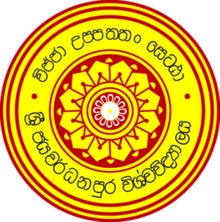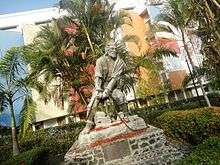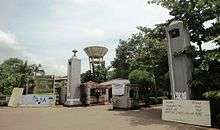University of Sri Jayewardenepura
| ශ්රී ජයවර්ධනපුර විශ්වවිද්යාලය | |
 | |
| Motto |
Vijja Uppattam Setta (among all that arise, knowledge is the greatest) |
|---|---|
| Established | 1959 (as Vidyodaya University) |
| Chancellor | Bellanvila Vimalarathana Thero |
| Vice-Chancellor | Sampath Amaratunge |
Administrative staff | 800 |
| Undergraduates | 14,000 |
| Postgraduates | 900 |
| Location |
Nugegoda, 6°51′11.710″N 79°54′9.96″E / 6.85325278°N 79.9027667°E |
| Campus | Main premises at Gangodawila |
| Affiliations |
University Grants Commission of Sri Lanka, Association of Commonwealth Universities |
| Website |
www |
 | |
The University of Sri Jayewardenepura (also referred as Jayewardenepura University or USJP) (Sinhalese: ශ්රී ජයවර්ධනපුර විශ්වවිද්යාලය, Tamil: ஸ்ரீ ஜயவர்தனபுர பல்கலைக்கழகம்) is a university in Sri Lanka. It is in Gangodawila, Nugegoda, near Sri Jayewardenepura Kotte, the capital city. It was formed in 1958 out of the Vidyodaya Pirivena, a Buddhist educational centre which was founded in 1873 by Ven. Hikkaduwe Sri Sumangala Thera.[1]
History

In 1956, following a change of government with Solomon West Ridgeway Dias Bandaranaike as the prime minister and following the policy of promoting national languages and culture, it was decided to establish two new universities by conferring university status on the Vidyodaya and Vidyalankara Pirivenas.[2] Accordingly, the Vidyodaya University and Vidyalankara University Act No. 45 of 1958 established the universities at the Vidyodyaya Pirivena at Maligakanda and the Vidyalankara Pirivena at Kelaniya. In 1958, it was reconstituted as the Vidyodaya University of Ceylon.

In 1961, a new location was selected at Gangodawila, 15 kilometres (9.3 mi) southeast from the center of Colombo and in walking distance of a main trunk road known as the High Level Road (A4). This road connects Colombo to Ratnapura and beyond. Part of these lands belonged to the nearby Sunethradevi Pirivena, associated with King Parakramabahu VI (1412–1467). The shift of the university to the new site was effected on 22 November 1961, under the direction of Sri Soratha Thera. The vice-chancellor invited the Department of the Government Archives to establish its archives within the campus, close to the University Library, to encourage research.
When Walpola Rahula was the vice-chancellor,[3] the university grew significantly in stature. When Rahula left the university in 1969, linguist D. E. Hettiarachchi took over. A noted employee of at this time was Mahinda Rajapaksa, who was chairman of the United Corporations and Mercantile Union local on the campus. He later went on to be President of Sri Lanka.
Its full-time student population is over 8,500,[4] enrolled in the faculties of Applied Sciences, Engineering, Graduate Studies, Humanities and Social Sciences, Management Studies and Commerce, Medical Sciences, and Technology.
Faculties


The university has seven main faculties: Applied Sciences, Engineering, Graduate Studies, Humanities and Social Sciences, Management Studies and Commerce, Medical Sciences, and Technology.
In 1962, Department of Science elevated to a Faculty of Applied Sciences and G. C. N. Jayesuriya became the first Dean of the Faculty. The current Dean of the Faculty is Sudantha Liyanage from the Department of Chemistry.
The Department of Medical Education and Health Sciences (DME&HS) was established to improve and sustain the quality of the learning/teaching processes in the faculty and to conduct certificate, diploma of degree courses in Health Sciences. Although Medical Education units are in the university system, the DME&HS is the 'first and only one' department established under the system to develop, implement and review activities related to improving the efficiency of learning/teaching related to Medical and Health Sciences. The DME&HS is successfully facilitating collaborative work in implementing medical and para-medical (Allied Health Sciences) programmes including Nursing, Pharmacy and Medical and Laboratory Science degrees.
The Postgraduate Institute of Management is a semi-autonomous body affiliated to the university. It promotes advanced education and professionalism in management in Sri Lanka through the provision of postgraduate instruction, training, research, and development in the branches of management and administrative studies.
Historically related institution
The Vidyalankara University was created at the same time as the Vidyodaya University. Today Vidyalankara University is known as the University of Kelaniya.
Ragging
The University of Sri Jayewardenepura is noted for a high level of ragging in recent years with several major incidents grabbing national headlines. These include the killing of Samantha Vithanage, who pioneered an anti-ragging campaign, by pro-ragging JVP supporters[5][6] and the resignation of Chandima Wijebandara, the vice chancellor of the university, in protest against the ragging.[7]
References
- ↑ Commemoration speech, University of Sri Jayewardenepura
- ↑ "News.lk". Retrieved 16 July 2015.
- ↑ Venerable Walpola Rahula: A brief biographical sketch by Udaya Mallawarachchi, Buddhist Studies in Honour of Walpola Rahula, 1980, ISBN 0-86092-030-5
- ↑ University Grants Commission of Sri Lanka, Undergraduates admitted, number enrolled and graduate output of Universities by academic streams 2000-2006
- ↑ "Ragging in our universities: A symptom or a disease?". Retrieved 16 July 2015.
- ↑ Nanda Wickramasinghe (2 December 2002). "JVP-inspired violence leads to crackdown on Sri Lanka campuses - World Socialist Web Site". Retrieved 16 July 2015.
- ↑ "News". Retrieved 16 July 2015.